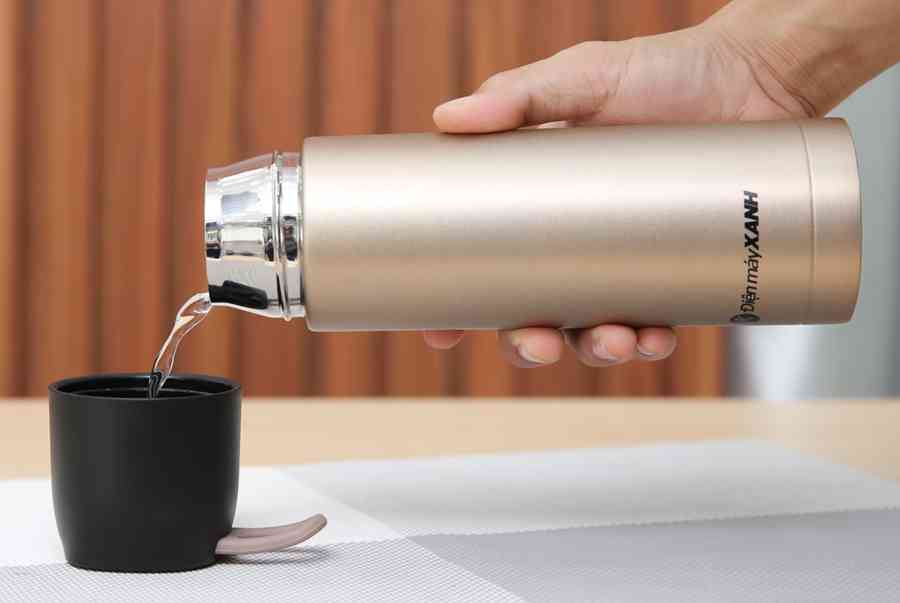Asus’s Best AiMesh Router Sub-1Gbps Combos | Dong Knows Tech
Looking for the best AiMesh router or wondering if the one you have is an excellent fit for your need? You’re reading the right post.
You’ll find here specific AiMesh routers and my recommendation on how to pair them with others to form a robust Wi-Fi system that can handle sub-Gigabit bandwidth needs, which is the case for most homes.
This piece is part of my series on Asus’s AiMesh. Check out the related post below if you have other questions.
Dong’s note: I first published this piece on February 28, 2021, and last updated it on April 18, 2023, to add more relevant information.

Best AiMesh routers and combos: The battle-tested list
This selection results from many hours — days, weeks, months, and even years in many cases — of testing and real-world usage via dozens of AiMesh combos I’ve used (or had access to) since Asus first introduced this feature in early 2018.
It consists of AiMesh routers and purposed-built systems, all after my extensive first-hand experience from a few weeks to tens of months.
AiMesh and firmware
Asus regularly releases firmware updates, a Linux-based operating system called Asuswrt, for its routers. Many of these updates add new features to the hardware — they do more than patch security vulnerabilities.
Some updates may inadvertently cause a particular model to go haywire, likely because the company tries to do so much with its routers.
As a result, firmware is a tricky thing with Asus. When it comes to updating — especially in an AiMesh setup of mixed hardware units using wireless backhauling — keep the following three items in mind:
- Avoid the initial major release(*): This is the first firmware version of a model where the 3xx number changes, such as from 384 to 386 or from 386 to 388. Generally, the latest minor update of the previous major firmware release is always the most stable.
- Avoid using Auto-Update for firmware: You should update the firmware when you see fit instead of letting the hardware update itself.
- Version consistency (in a mesh system): Generally, it would be best to use the firmware version of the same major release for all AiMesh members. (Mixing hardware of different releases might produce mixed results.)
On the one hand, moving between major releases might break your AiMesh setup or even your standalone router. On the other, new hardware comes with a specific initial version out of the box — you have no option to downgrade it — and some old models won’t get the latest release. So depending on the mesh combo, your luck will vary.
As a rule, in a mesh system, it’s best to wait for a few minor updates of a major release before upgrading. Depending on the hardware combo, you might need to rebuild the system from scratch or reset and re-add a satellite node if you change the major firmware version (in one or all hardware units involved.)
I sorted this list in the order of my experience, newest on top — the order is not the ranking. Go through the entire post to find out which fits your needs and budget.
 The Asus ZenWifi XD5 includes three identical mesh routers.
The Asus ZenWifi XD5 includes three identical mesh routers.
The ZenWifi XD5 replaces the XD4, which is no longer available, as the low-cost AiMesh system.
Thanks to the support for a faster 5GHz band, it’s an excellent mesh for a wired home. Additionally, it makes ideal satellites for a system hosted by Dual-band Wi-Fi 6 routers.
- Backhaul: Wired (recommended) or wireless (acceptable in star topology).
- Recommended nodes: Itself or the RP-AX58, preferably via wired backhauling, but wireless will also work for those with modest broadband.
- Recommended the main router:
- Wireless: Dual-band Wi-Fi 6 router with DFS support.
- Wired: Any dual-band Wi-Fi 6 routers.
- AiMesh 2.0 support: Yes (including system-wide Guest network), starting with the initial firmware.
 The Asus ZenWiFi XD6 AX5400 Dual-band Mesh Wi-Fi System includes two identical dual-band routers.
The Asus ZenWiFi XD6 AX5400 Dual-band Mesh Wi-Fi System includes two identical dual-band routers.
If the ZenWiFi XT8 (below) is the AiMesh choice for a wireless home, the ZenWiFi XD6 is the wired alternative.
This dual-band purpose-built mesh system is ideal for a home already wired with network cables. Sure, it’ll work well in a wireless setup, but getting your house wired is the way to go if you want close to full Gigabit performance.
The XD6 works great by itself, but if you want to mix it with other routers:
- Backhaul: Wired (recommended) or wireless (acceptable, only as a 2-pack).
- Recommended nodes: Itself or the XD5, preferably via wired backhauling, but wireless will also work for those with modest broadband.
- Recommended the main router:
- Wireless: Wi-Fi 6 router with a 4×4 5GHz band.
- Wired: Any dual-band Wi-Fi 6 routers.
- AiMesh 2.0 support: Yes (including system-wide Guest network), starting with the initial firmware.
The ZenWiFi XD6 works best as a wired system by itself (you can use up to six hardware units) or the satellites for a similarly-specced or higher-tier router, such as the RT-AX86U, RT-AX82U, GS-AX5400, RT-AX88U, or the RT-AX89X.
Mục Lục
Asus ZenWiFi XD6’s Rating


Performance
9 out of 10
Features
9.5 out of 10
Design and Setup
9 out of 10
Value
8 out of 10
Pros
Fast and reliable Wi-Fi performance
AiMesh 2.0 fully supported
Lots of network settings and useful features, including free real-time online protection for life
Compact design
Presynced hardware, 160Mhz support
Cons
No Multi-Gig or Link aggregation
No USB port
 The Asus GS-AX5400 (left) and TUF-AX5400 work well in an AiMesh setup.
The Asus GS-AX5400 (left) and TUF-AX5400 work well in an AiMesh setup.
These three gaming routers are the alternatives to the RT-AX82U, and RT-AX3000 mentioned below. And they are excellent AiMesh members.
The three are very similar in design and features — they are part of Asus’s new ROG STRIX and TUF gaming series.
The GS-AX5400 and TUF-AX5400 are virtually identical regarding hardware specs while looking different. On the other hand, the GS-AX5400 and GS-AX3000 look the same but of different Wi-Fi tiers.
Since these are dual-band broadcasters, it’s best to use them (either as primary routers or satellite nodes) in a wired setup. But a wireless configuration works, too, especially for the two AX5400 broadcasters, which have the top-tier 5GHz band.
Notes on using AiMesh:
- Backhaul: Wired (recommended) or wireless (acceptable).
- Recommended nodes:
- Wireless: Wi-Fi 6 router with a 4×4 5GHz band, namely itself.
- Wired: Any dual-band Wi-Fi 6 or Wi-Fi 5 routers.
- AiMesh 2.0 support: Yes (including system-wide Guest network), starting with the initial firmware.
- Nodes I’ve used: Themselves, RT-AX86U, RT-AX82U, ZenWifi XD5.
Asus ROG STRIX GS-AX5400’s Rating
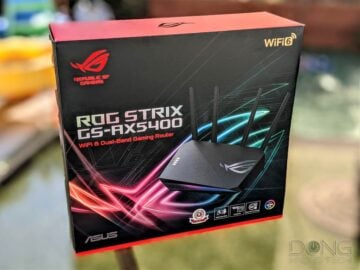
Performance
9.5 out of 10
Features
9.5 out of 10
Ease of Use
8 out of 10
Value
8 out of 10
Pros
Excellent overall performance
Complete AiMesh 2.0 support, including system-wide Guest network
Robust web interface, well-designed mobile app, no login account required
Lots of useful features, including those for gamers
Cool-looking front-facing AURA Game light
Cons
No Multi-Gig port or Gamer VPN (WTFast)
Performance as a NAS server could be better
The ROG logo doesn’t light up, a bit boring
 The Asus RP-AX56 AX1800 Dual-Band Wi-Fi 6 Repeater comes in a plug-in design.
The Asus RP-AX56 AX1800 Dual-Band Wi-Fi 6 Repeater comes in a plug-in design.
The RP-AX56 (or its replacement, the RP-AX58) is an extender (repeater) by design and can work with any router. But it works best as an AiMesh node in a wired (recommended) or wireless setup.
Note, though, that this is a modest piece of hardware. It features 2×2 80MHz Wi-Fi 6 and therefore caps at 1.2Gbps at best. Most importantly, it can’t handle DFS or 160MHz channels and won’t work with a router that uses these settings in a wireless setup.
That said, this is a satellite node for those using an entry-level AiMesh router or a high-end one set up with wired backhaul or in compatibility mode (wireless backhaul).
Notes on using AiMesh:
- Backhaul: Wired (recommended) or wireless (acceptable).
- Recommended router:
- Wireless: Dual-band 2×2 Wi-Fi 6 routers. Repeater mode is available.
- Wired: Any dual-band Wi-Fi 6 routers. AP mode is available.
- AiMesh 2.0 support: Yes, with a system-wide Guest network (with the latest firmware.)
- Routers I’ve tried: RT-AX82U, RT-AX3000, RT-AX89X.
Asus RP-AX56/58 Repeaters’ Rating

Performance
8.5 out of 10
Features
8.5 out of 10
Ease of Use
8 out of 10
Value
8.5 out of 10
Pros
Affordable
Reliable and relatively fast Wi-Fi (for the specs) with good coverage
Can work as an Access Point, a Media Bridge, an Extender, or an AiMesh node (via wireless or wired backhaul)
Convenient design, excellent web interface
Cons
Modest 2×2 specs; only one Gigabit port; no Mulit-Gig support
Bulky for a snap-on device
 Best AiMesh Router Combos: The RT-AX68U is likely one of the most affordable AiMesh routers.
Best AiMesh Router Combos: The RT-AX68U is likely one of the most affordable AiMesh routers.
The RT-AX68U is a bit special. It’s the only 3×3 Wi-Fi 6 router on this list, and it’s also quite affordable. It’s a better version of the RT-AC68U that came out several years ago.
Notes on using AiMesh:
- Backhaul: Wired (recommended) or wireless (acceptable).
- Recommended nodes:
- Wireless: Wi-Fi 6 router with a 3×3 5GHz band, namely itself.
- Wired: Any dual-band Wi-Fi 6 or Wi-Fi 5 routers.
- AiMesh 2.0 support: Yes (including system-wide Guest network), starting with the initial firmware.
- Nodes I’ve used: RT-AX68U, ZenWiFi Mini XD4 (wired backhaul).
Asus RT-AX68U’s Rating

Performance
8.5 out of 10
Features
9.5 out of 10
Ease of Use
8.5 out of 10
Value
9 out of 10
Pros
Fast performance, excellent range, reliable
Tons of helpful networking features and settings, including AiMesh 2.0
Robust web UI, well-designed mobile app
Excellent NAS performance and features when hosting a storage device
Comparatively affordable
Cons
No Multi-Gig ports or 160MHz channel width support (at launch)
Not wall-mountable
 Best AiMesh Router Combos: The Asus RT-AX86U is an excellent AiMesh host
Best AiMesh Router Combos: The Asus RT-AX86U is an excellent AiMesh host
The Asus RT-AX86U is a safe choice to be an AiMesh primary router. It’s one of the best dual-band routers on the market.
On top of that, this router is an excellent Multi-Gig satellite when working with the RT-AX89X.
Notes on using AiMesh:
- Backhaul: Wired (recommended) or wireless (acceptable when using same-tier routers).
- Recommended nodes:
- Wireless: Dual-band Wi-Fi 6 routers with a 4×4 5GHz band.
- Wired: Any Dual-band Wi-Fi 5 or Wi-Fi 6 routers.
- AiMesh 2.0 support: Yes (including system-wide Guest network), starting with firmware version 3.0.0.4.386.41535.
- Nodes I’ve used: RT-AX86U, RT-AX82U, RT-AX88U, RT-AX58U, RP-AX56/58, ZenWiFi XD4, GS-AX5400, and GS-AX3000.
Asus RT-AX86U’s Rating

Performance
9 out of 10
Features
9.5 out of 10
Ease of Use
8.5 out of 10
Value
9 out of 10
Pros
Fast performance, excellent range, reliable
Tons of helpful networking features and settings
Useful settings for online gaming
Robust web UI, well-designed mobile app
Multi-Gig, WAN/LAN Link Aggregation support
Excellent NAS performance and features when hosting a storage device
Comparatively affordable
Cons
Single, low-speed (2.5Gbps) Multi-Gig port
Not wall-mountable
Gaming features turn Adaptive QoS off
No support for WTFast Gamer VPN
 Best AiMesh Router Combos: The Asus RT-AX3000 and RT-AX58U make an excellent AiMesh pair.
Best AiMesh Router Combos: The Asus RT-AX3000 and RT-AX58U make an excellent AiMesh pair.
The RT-AX3000 is virtually the same as the RT-AX58U, and the pair makes an excellent AiMesh setup when you use the wired backhaul.
Notes on AiMesh:
- Backhaul: Wired (recommended) or wireless (not recommended).
- Recommended nodes:
- Wireless: Dual-band Wi-Fi 6 router with a 2×2 5GHz band.
- Wired: Any dual-band Wi-Fi 5 or Wi-Fi 6 routers of the same tier or lower.
- AiMesh 2.0 support: Yes (including system-wide Guest network), starting with firmware version 3.0.0.4.386.41700.
- Nodes I’ve used: RT-AX58U, RP-AX56 (wired and wireless), ZenWiFi XD4 (wired), RT-AC86U (wired).
Asus RT-AX3000 / RT-AX58U’s Rating

Performance
8.5 out of 10
Features
9 out of 10
Design and Setup
8 out of 10
Value
8.5 out of 10
Pros
160 MHz channel support
Fast and reliable performance
Tons of useful features with excellent AiMesh support
Full web interface and well-design mobile app
Compact design, wall-mountable
Cons
No multi-gig port or Link Aggregation
Modest hardware specs
Relatively short Wi-Fi range
The Parental Control feature could use some improvement
 Best AiMesh Router Combos: The Asus RT-AX82U and its unique programmable front-facing Aura RGB lighting.
Best AiMesh Router Combos: The Asus RT-AX82U and its unique programmable front-facing Aura RGB lighting.
The Asus RT-AX82U is almost the same as the RT-AX86U above in terms of performance and features. The two share the same 4×4 Wi-Fi 6 band, which is strong enough to handle both backhaul and clients in most cases.
Notes on AiMesh:
- Backhaul: Wired (recommended) or wireless (acceptable when using same-tier routers).
- Recommended nodes:
- Wireless: Dual-band Wi-Fi 6 routers with a 4×4 5GHz band.
- Wired: Any Dual-band Wi-Fi 5 or Wi-Fi 6 routers.
- AiMesh 2.0 support: Yes (including system-wide Guest network), starting with firmware version 3.0.0.4.386.41700.
- Nodes I’ve used: RT-AX86U, RT-AX58U, ZenWiFi XD4, RT-AC86U, GS-AX5400, GS-AX3000, RP-AX58/56.
Asus RT-AX82U’s Rating
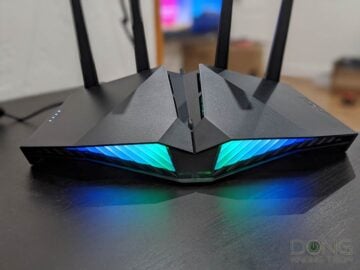
Performance
8.5 out of 10
Features
9.5 out of 10
Ease of Use
8.5 out of 10
Value
9.5 out of 10
Pros
Excellent performance
Beautiful design with tons of helpful networking, game-related features, and settings
Robust web UI, well-designed mobile app
Comparatively affordable
Cons
No support for WTFast Gamer VPN
No multi-gig network port
Network storage performance (when hosting a portable drive) could use some improvement
Not wall-mountable
 Best AiMesh Router Combos: That’s my hand on the Asus RT-AX89X Wi-Fi 6 router.
Best AiMesh Router Combos: That’s my hand on the Asus RT-AX89X Wi-Fi 6 router.
The Asus RT-AX89X is quite different since it’s the only Wi-Fi 6 router on this list that uses a Qualcomm chip. As a result, it doesn’t have the best support for AiMesh — it works best as a standalone router.
But if you’re building a wired network, it can still work as an excellent host. When coupled with the RT-AX86U (as a satellite), the RT-AX89X is one of the best router options for building a Multi-Gig AiMesh network.
Notes on AiMesh:
- Backhaul: Wired only. I didn’t have a good experience using this router in a wireless AiMesh setup.
- Recommended nodes: Any dual-band Wi-Fi 6 or Wi-Fi 5 routers.
- AiMesh 2.0 support: Yes, with a system-wide Guest network (via the latest firmware).
- Satellinite nodes I’ve used: RT-AX88U, RT-AX58U, ZenWiFi XD5, RT-AC86U, GS-AX5400, GS-AX3000, and more.
Asus RT-AX89X’s Rating

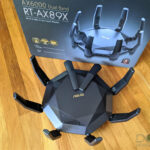
Performance
9.5 out of 10
Features
9 out of 10
Design and Setup
9 out of 10
Value
8.5 out of 10
Pros
Excellent Wi-Fi performance
Uniquely cool design with two 10Gbps network ports
Eight Gigabit network ports with Dual-WAN and Link Aggregation
Super-fast network-attached storage speed when coupled with an external drive
Tons of useful features, including free-for-life real-time online protection and AiMesh
Cons
A bit buggy at launch, relatively expensive
Bulky physical size with an internal fan — potential heat issue in hot environments
Web interface needs work
Not wall-mountable, no universal backup restoration
 Best AiMesh Router Combos: The RT-AX88U comes in a traditional design of a Wi-Fi router.
Best AiMesh Router Combos: The RT-AX88U comes in a traditional design of a Wi-Fi router.
In many ways, the RT-AX88U is the Wi-Fi 6 version of the RT-AC88U, which is an excellent router. The two look almost identical and share many similar features, including the eight Gigabit LAN ports and the lack of a multi-gig port.
Notes on AiMesh:
- Backhaul: Wired (recommended) or wireless (acceptable when using same-tier routers).
- Recommended nodes:
- Wireless: Dual-band Wi-Fi 6 routers with a 4×4 5GHz band.
- Wired: Any Dual-band Wi-Fi 5 or Wi-Fi 6 routers.
- AiMesh 2.0 support: Yes (including system-wide Guest network), starting with firmware version 3.0.0.4.386.41700.
- Satellite nodes I’ve used: RT-AX88U, RT-AX86U, RT-AX58U, ZenWiFi XD4 (wired backhaul), RT-AC86U (wired), RT-AC88U (wired).
Asus RT-AX88U’s Rating


Performance
8.5 out of 10
Features
8.5 out of 10
Design and Setup
8.5 out of 10
Value
8 out of 10
Pros
Fast Wi-Fi performance
Tons of useful features
Eight network ports with Dual-WAN and Link Aggregation
Universal setting backup and restoration
Fast network-attached storage speed when coupled with an external drive.
Merlin firmware support
Cons
No multi-gig network port
Buggy firmware (at review)
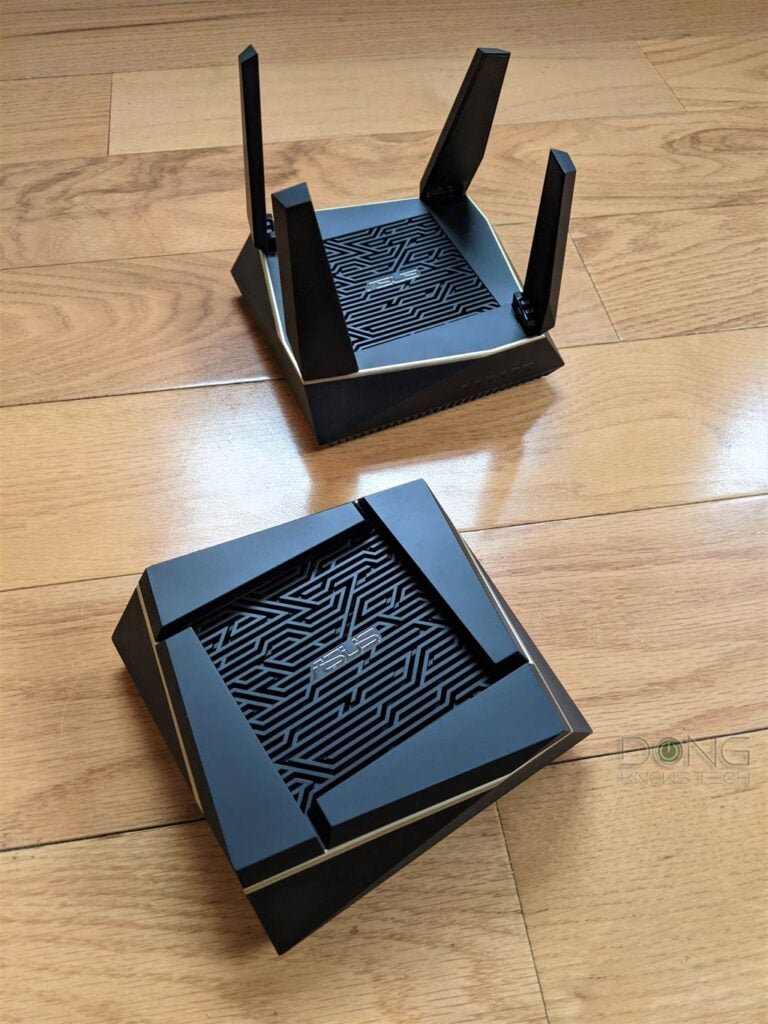 Best AiMesh Router Combos: A 2-pack Asus RT-AX92U makes an excellent wireless AiMesh.
Best AiMesh Router Combos: A 2-pack Asus RT-AX92U makes an excellent wireless AiMesh.
A 2-pack Asus RT-AX92U makes an excellent AiMesh wireless mesh system. It also supported wired backhaul well. In many ways, it’s the mini version of the GT-AX11000 below.
Notes on AiMesh:
- Backhaul: Wired or wireless (tri-band routers only).
- Recommended nodes:
- Wireless: Tri-band Wi-Fi 6 routers of the same tier, namely itself. 5GHz band works as the dedicated backhaul.
- Wired: Any Wi-Fi 5 or Wi-Fi 6 routers. In this case, the 5GHz-2 band is available only at tri-band nodes.
- AiMesh 2.0 support: Yes (including system-wide Guest network), starting with firmware version 3.0.0.4.386.41712.
- Satellite nodes I’ve used: RT-AX92U.
ASUS RT-AX92U’s Rating

Performance
8.5 out of 10
Features
8.5 out of 10
Ease of Use
8 out of 10
Value
9 out of 10
Pros
Compact design, tri-band specs
Good performance, large coverage
Excellent set of features, including online protection, WTFast VPN for gamers, and system-wide Guest network when working as a mesh
Link Aggregation and Dual-WAN support, wall-mountable
Comparatively affordable
Cons
Wi-Fi 6 available only on one of the 5GHz bands
No Multi-Gig port
 Best AiMesh Router Combos: The Asus GT-AX11000 is a massive Wi-Fi 6 router.
Best AiMesh Router Combos: The Asus GT-AX11000 is a massive Wi-Fi 6 router.
The GT-AX11000 is the full-size version of the RT-AX92U above. It’s an excellent full-feature AiMesh host.
Notes on AiMesh:
- Backhaul: Wired or wireless (tri-band routers only).
- Recommended nodes:
- Wireless: Tri-band Wi-Fi 6 routers of the same tier, such as itself or the RT-AX92U. The 5GHz-2 band works as the (dedicated) backhaul in this case.
- Wired: Any AiMesh routers. In this case, the 5GHz-2 band is available only at tri-band nodes.
- AiMesh 2.0 support: Yes (including system-wide Guest network), starting with firmware version 3.0.0.4.386.41712.
- Satellite nodes I’ve used with success: RT-AX92U, RT-AX88U, RT-AX86U, RT-AX58U, ZenWiFi XT8, ZenWiFi XD4 (wired back).
Asus GT-AX11000’s Rating

Performance
8 out of 10
Features
9.5 out of 10
Design and Setup
8 out of 10
Value
7.5 out of 10
Pros
Fast and reliable Wi-Fi performance with an excellent range
Lots of useful features for home users
Unique and effective settings for online gaming
Multi-Gig network port, Dual-WAN, Link Aggregation
Mesh ready
Cons
Expensive
Bulky design, loose antennas, non-wall-mountable
Fewer LAN ports than the previous model
Long boot-up time, buggy (at launch), fluctuating Wi-Fi throughputs
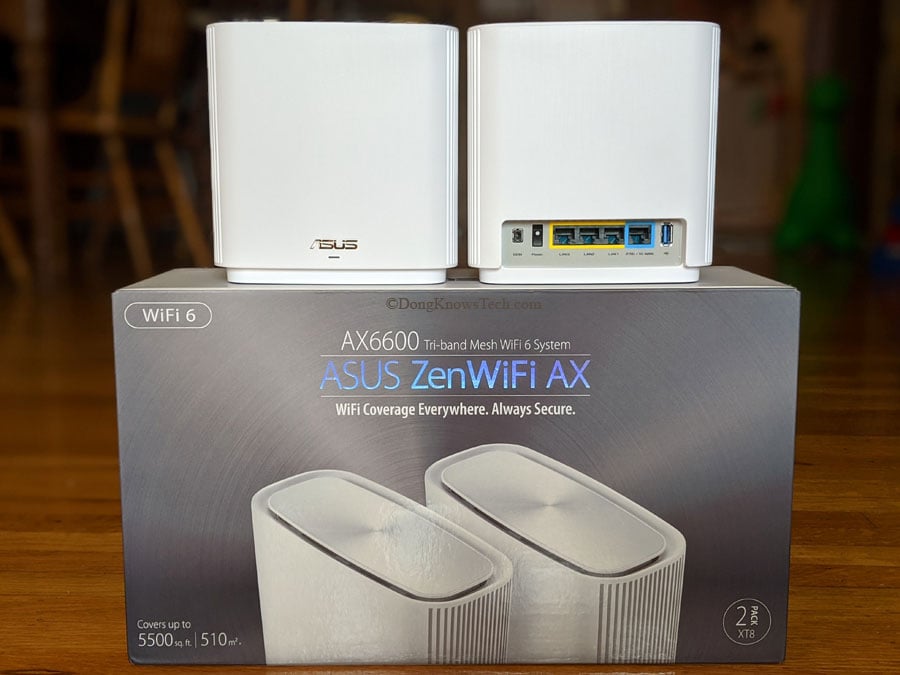 Best AiMesh Router Combos: The ZenWiFi AX XT8 includes two identical routers.
Best AiMesh Router Combos: The ZenWiFi AX XT8 includes two identical routers.
This set is the first purpose-built tri-band Wi-Fi 6 AiMesh set. As such, it’s intended primarily to work as a standalone wireless system (no network cables or other hardware involved.)
As a result, while this set support wired backhaul well, using a network cable to connect the two might cause issues when new firmware is released or deliver worse performance, which has happened multiple times since its release.
Notes on AiMesh:
- Backhaul: Wired (with caution) or wireless (recommended).
- Recommended nodes: Itself.
- AiMesh 2.0 support: Yes (vis latest firmware) with a system-wide Guest network.
- Real-world experience: multiple 2-pack and 3-pack sets.
Asus ZenWiFi XT8’s Rating

Performance
8.5 out of 10
Features
9.5 out of 10
Design and Setup
8.5 out of 10
Value
9 out of 10
Pros
Fast Wi-Fi performance and large coverage at a comparatively affordable cost
Improved and flexible AiMesh
Lots of network settings and useful features, including free real-time online protection for life
Full 4×4 dedicated backhaul band with optional wired backhaul support
Multi-Gig WAN port with Dual-WAN and WAN link aggregation
Cons
No 160MHz 4×4 support for Wi-Fi 6 clients in a dedicated wireless backhaul setup
No Multi-Gig LAN port or LAN link aggregation
Only four network ports on each hardware unit
Firmware can be buggy, especially via wired backhaul
Storage performance (when hosting an external drive) could be better
Wi-Fi 5 AiMesh hardware
Since late 2022, it’s been clear that Asus will not upgrade its Wi-Fi 5 routes to its latest 388 firmware revision, and many will not even get the 386 revision.
This doesn’t mean Wi-Fi 5 hardware is no longer supported — some still get new firmware with security patches.
 Best AiMesh Router Combos: A pair of RT-AC86U units will make a great legacy Wi-Fi AiMesh system.
Best AiMesh Router Combos: A pair of RT-AC86U units will make a great legacy Wi-Fi AiMesh system.
However, in terms of hardware combo, it’s best to use them all via wired backhauling and avoid mixing Tri-band and Dual-band hardware. Here are the bullet points on those I’ve tested when used as the primary AiMesh router:
- ZenWiFi AC CT8: Should be used by itself or as satellite nodes for the R-AC5300 or the GT-AC5300.
- RT-AC88U: Should be used with itself or the RT-AC86U.
- RT-AC86U: Should be used with itself or the RT-AC88U.
- Blue Cave: This one is stuck with the 384 firmware released and should be used with itself or the Lyra Trio.
- Lyra Trio: Also stuck with 384 firmware and should be used by itself.
Finally, all Wi-Fi 5 AiMesh hardware with 386 firmware revision support AiMesh 2.0 and delivers a system-wide Guest network. Those with 384 releases remain at the original version of AiMesh, which is relatively limited in features.
The takeaway
There you go. Pick a combo mentioned above (using the recommended backhaul), and I can almost guarantee you’ll build an excellent mesh system.
Keep in mind that there might be other excellent combos I’ve not tested, and I haven’t used all the different scenarios of those mentioned here.
The key is not to mess around too much or upgrade the firmware willy-nilly when everything is working. Keep that in mind, especially when you use the Asus mobile app.





